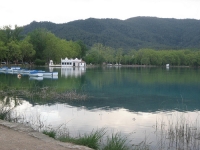
Just north of Girona, the historic lakeside town of Banyoles is well known for hosting international rowing events. But it is also a fun, attractive, and interesting place to visit and perhaps work off some energy in a pedal-boat or on a bicycle. The bright blue lake itself is the only one in the world fed by two merging subterranean rivers. There are numerous options available to those wanting to take to the water, from a swimming dock to cruises or hire boats, and a grassy bank for sunbathers or a network of shady footpaths for those who prefer the shore. The town of Banyoles dates from 812, having developed around a Benedictine monastery. Its old section is full of fascinating ancient buildings, including the Sant Esteve de Banyoles Monastery, the Gothic Church of Santa Maria dels Turers, and the Gothic palace called the Pia Almoina. The natural history and archaeological museums are worth visiting, and all are centred around a lovely arcaded square where a traditional market has been held every Wednesday since medieval times.
Address : Tourist Office: 25 Passeig de la Industria.
Website : http://www.spain.info/en/que-quieres/ciudades-pueblos/otros-destinos/banyoles.html
Telephone : Tourist Office: +34 972 575 573
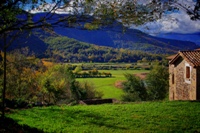
Visiting the dormant volcanoes is not one of the typical things to do in Spain. Yet they offer stunning scenery and a one-of-a-kind experience. Sandwiched between the Pyrenees and Costa Brava, the region of Garrotxa is home to a multitude of prehistoric volcanoes as well as many castles and country houses. Visitors wanting to experience more of Spain than the quintessential beach and city breaks should head to Garrotxa Nature Reserve, just outside of Girona, to experience a land of amazing and rugged landscapes, fire, and ash. The reserve showcases the best of rural tourism in Spain and is perfect for enthusiastic hikers. The volcanoes in this area formed over 11,000 years ago and the region is unique to Europe. Visitors can walk, hike, or horse ride along any number of tracks and trails in the reserve and enjoy a land of stark contrasts. There are also hot air balloon rides available in the reserve, which is a very exciting way to experience the beauty of the region. Some chefs in Garrotxa create what they call 'volcanic cuisine', trying to express the landscape through food, and Michelin-starred restaurants like Les Cols are the perfect place to sample these interesting meals.
E-mail : [email protected]
Website : www.turismegarrotxa.com/_es.html
Telephone : +34 972 266 012
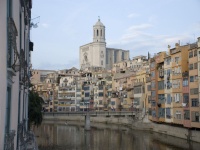
The city of Girona, on the route from the Pyrenees to Barcelona, is one of the most important historical sites in Spain, founded by the Romans and later turned into a Moorish stronghold. Sitting astride the confluence of the Onyar and Ter rivers, this quaint medieval city attracts hordes of tourists from the Costa Brava resorts and Barcelona. All are lured by the experience of walking through the old quarter, the Call, with its narrow alleyways and ancient stone houses. Inside the ancient walls are such gems as the 12th-century Benedictine monastery of Sant Pere de Galligants and the 14th-century cathedral built in the Catalonian Baroque style. The cathedral can be accessed by climbing up 90 steps. It includes a museum containing art works and rare manuscripts. Also of particular interest are the restored 12th-century Arab baths with their central octagonal pool, and the fascinating Jewish quarter where, between the 9th and 15th centuries, the culture and religion flourished on the narrow, steep streets. The arcaded promenade, the Rambla de la Llibertat, is lined with delightful cafes and shops selling souvenirs, crafts, antiques, and curiosities. In addition, the city is well supplied with museums and galleries.
Address : Tourist office: Joan Maragall, 2
E-mail : [email protected]
Website : www.girona.cat
Telephone : Tourist office: +34 972 010 001
Opening times : Tourist office: Monday to Friday from 8am to 8pm, and on Saturday from 8am to 2pm and 4pm to 8pm. In July and August the office is also open on Sundays, from 9am to 2pm
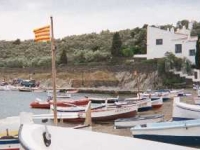
The busy fishing village of Cadaques draws plenty of visitors, but they do not come for the local beach, which is rather narrow and stony. Rather, the resort town's attractions are its picturesque natural harbour, some excellent restaurants, numerous galleries, fashion, and art and craft shops, and the former home-turned-museum of world-renowned surrealist painter, Salvador Dali, situated in nearby Portlligat Bay. Dali's bizarre home consists of a labyrinthine cluster of fishermen's huts, added to the original building in various stages by the artist over a period of 40 years. Visitors must reserve a time for entry in advance as only about eight people are allowed in the museum at a time. You can book via the website, by phone, or by email and must arrive at the museum to collect your tickets at least half an hour before your appointed entry time. Touching any of the art is strictly forbidden. Despite how strict this all sounds, the staff are very friendly and the limited admission makes the experience more intimate and rewarding. Tours are not guided and the house is remarkable, as one would expect from Dali. The house is very prettily located and there are lovely sea views from some of the windows.
Address : Portlligat, Cadeques.
E-mail : [email protected]
Website : https://www.salvador-dali.org/en/
Telephone : +34 972 251 015
Transport : Train to Llanca or Figueres station. It is possible to walk to Portlligat from Llanca station, or to take the bus from Figueres.
Opening times : Open daily but opening times vary according to season and day. Entry to the museum must be reserved in advance as numbers inside are limited.
Admission : €12 (general); €8 (reduced); children under 9 free.
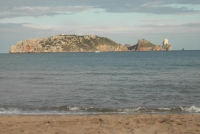
Situated scarcely a mile from the beach of the popular resort town of L'Estartit on the Costa Brava, the protected Medes Islands are seen as heaven for divers. It may not look like much above water, but the craggy little archipelago of seven islets and a few reefs form one of the most important and rich marine reserves in the Mediterranean. Meda Gran, the largest of the islands, is the only one of considerable size, and there is a 10th-century lighthouse on it. Most of the islands are just rocky outcrops jutting out of the sea, with little vegetation. However, the magic happens underwater: millions of fish and thousands of animal and plant species inhabit the shallows, crevices, and submarine caves at the base of the island cliffs, and are a delight to behold for divers of all levels of experience, whether splashing with a snorkel or descending to the depths in scuba gear. Visitors can take glass-bottomed boat trips around the islands, departing hourly in season from L'Estartit, or arrange a fully equipped diving trip through one of the numerous tourist diving centres in the resort town.

Travel Guide powered by Word Travels, copyright © 2023 Globe Media Ltd. By its very nature information in this travel guide is subject to change at short notice and travellers are urged to verify information on which they're relying with the relevant authorities. Neither Globe Media Ltd nor Travel Vogue can accept any responsibility for any loss or inconvenience to any person as a result of information contained above.